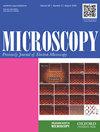Practical implementation of high-resolution electron ptychography and comparison with off-axis electron holography
IF 1.8
4区 工程技术
引用次数: 0
Abstract
Ptychography is a coherent diffractive imaging technique that can determine how an electron wave is transmitted through an object by probing it in many small overlapping regions and processing the diffraction data obtained at each point. The resulting electron transmission model describes both phase and amplitude changes to the electron wave. Ptychography has been adopted in transmission electron microscopy in recent years following advances in high-speed direct electron detectors and computer algorithms which now make the technique suitable for practical applications. Its ability to retrieve quantitative phase information at high spatial resolution makes it a plausible alternative or complement to electron holography. Furthermore, unlike off-axis electron holography, it can provide phase information without an electron bi-prism assembly or the requirement of a minimally structured region adjacent to the region of interest in the object. However, it does require a well-calibrated scanning transmission electron microscope and a well-managed workflow to manage the calibration, data acquisition and reconstruction process to yield a practical technique. Here we detail this workflow and highlight how this is greatly assisted by acquisition management software. Through experimental data and modelling we also explore the similarities and differences between high-resolution ptychography and electron holography. Both techniques show a dependence of the recovered phase on the crystalline orientation of the material which is attributable to dynamical scattering. However, the exact nature of the variation differs reflecting fundamental expectations, but nonetheless equally useful information is obtained from electron holography and the ptychographically determined object transmission function.高分辨率电子ptychography的实际实现及其与离轴电子全息术的比较
Ptychography是一种相干衍射成像技术,它可以通过在许多小的重叠区域中探测电子波并处理在每个点获得的衍射数据来确定电子波是如何通过物体传输的。由此产生的电子传输模型描述了电子波的相位和振幅变化。近年来,随着高速直接电子探测器和计算机算法的进步,Ptychography已被用于透射电子显微镜,这使得该技术适合实际应用。它能够以高空间分辨率检索定量相位信息,这使它成为电子全息术的一种可行的替代或补充。此外,与离轴电子全息术不同,它可以在没有电子双棱镜组件或与物体中感兴趣区域相邻的最小结构区域的要求的情况下提供相位信息。然而,它确实需要一台校准良好的扫描透射电子显微镜和一个管理良好的工作流程来管理校准、数据采集和重建过程,以产生一种实用的技术。在这里,我们详细介绍了这一工作流程,并强调了采购管理软件如何在很大程度上帮助实现这一点。通过实验数据和建模,我们还探索了高分辨率ptychography和电子全息术之间的异同。这两种技术都显示出回收相对材料晶体取向的依赖性,这可归因于动态散射。然而,变化的确切性质不同,反映了基本的预期,但从电子全息术和物理摄影确定的物体传输函数中获得了同样有用的信息。
本文章由计算机程序翻译,如有差异,请以英文原文为准。
求助全文
约1分钟内获得全文
求助全文
来源期刊

Microscopy
工程技术-显微镜技术
自引率
11.10%
发文量
0
审稿时长
>12 weeks
期刊介绍:
Microscopy, previously Journal of Electron Microscopy, promotes research combined with any type of microscopy techniques, applied in life and material sciences. Microscopy is the official journal of the Japanese Society of Microscopy.
 求助内容:
求助内容: 应助结果提醒方式:
应助结果提醒方式:


